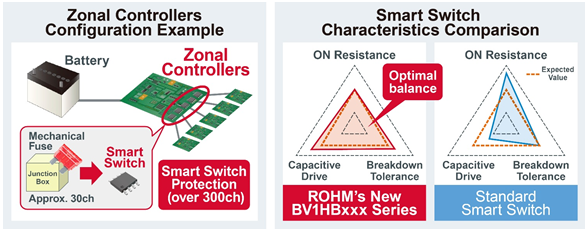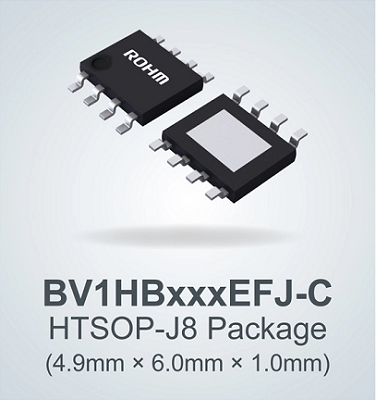ROHM has developed six new high-side Smart Switches (Intelligent Power Devices, short: IPDs) BV1HBxxxEFJ series (BV1HB008EFJ-C, BV1HB012EFJ-C, BV1HB020EFJ-C, BV1HB040EFJ-C, BV1HB090EFJ-C, BV1HB180EFJ-C) with highly accurate current sensing capability and ON resistances from 9 mΩ to 180 mΩ. They are ideal for protecting loads and subsystems from abnormalities such as overcurrent, overvoltage, and overtemperature, ensuring reliable operation and safeguarding sensitive components in automotive lighting, body control such as, door locks and power windows. Extensive diagnostic capabilities, e.g., open load and reverse battery detection, further enhances safety and reliability.
Vehicle electronic control systems are becoming increasingly sophisticated with the advancement of autonomous driving and electric vehicles (EVs). This evolution has heightened the importance of electronic protection from a functional safety standpoint, driving the shift toward Zonal Controllers architecture that manages vehicle functions in designated zones. As a result, the use of smart switches for electronic load protection and control is rapidly growing.
Zonal controllers must each manage a large number of loads, but conventional smart switches often lack the drive capability required for high-capacitance loads. ROHM’s new smart switches address this challenge, delivering key performance attributes such as low ON resistance and high inductive energy clamp while significantly improving capacitive load drive capability. By commercializing high-performance smart switches tailored to zonal controllers’ requirements, ROHM is contributing to automotive electrification and the elimination of mechanical fuses.
The new products feature exceptional high-capacitance load driving capability, maximizing performance at the critical interface between Zonal Controllers and output loads (including various ECUs). Leveraging proprietary cutting-edge process technology makes it possible to achieve both low ON resistance and high inductive energy clamp – two characteristics typically involve a trade-off. The result is a well-balanced integration of three key performance metrics: drive capability, ON resistance, and energy tolerance. This enhances system design safety, efficiency, and reliability. The devices also incorporate a best-in-class* high-precision current sensing function (±5%) that provides effective protection for harnesses connected to output loads. At the same time, the compact, high heat dissipation HTSOP-J8 package ensures excellent design versatility.
Going forward, ROHM remains committed to improving safety, security, and energy efficiency in the automotive field by continuing to develop high reliability, high performance devices.

New Product Lineup (High Side Smart Switches with Current Sense)

Application Examples
Body applications, powertrain/inverter systems, other switch-related circuits
Online Sales Information
Sales Launch Date: Now
Pricing: 4.1 US$/unit (samples, excluding tax)
Online Distributors: Digi-Key, Mouser, and Farnell
Part Nos: BV1HB008EFJ-CE2, BV1HB012EFJ-CE2BV1HB020EFJ-CE2, BV1HB040EFJ-CE2, BV1HB090EFJ-CE2, BV1HB180EFJ-CE2
Terminology:
Zonal Controllers
An emerging design concept in automotive electronic architecture, zonal controllers represent a shift away from the conventional approach of assigning dedicated ECUs for each function, such as lighting, door locks, and power windows. Instead, the vehicle is divided into zones, with a zonal controller manages multiple functions in its zone
Intelligent Power Devices (IPD) / Smart Switches
Smart power switches are semiconductor devices that electronically control the delivery of power by turning it on and off, while also providing integrated protection and diagnostic features such as overcurrent, overvoltage, thermal shutdown, current sensing, and open load detection to enhance system reliability and safety.
Capacitive Load Driving Capability
A technical term referring to the ability of an electronic circuit or semiconductor device to operate reliably when driving capacitive loads. It is especially important in circuit configurations involving zone ECUs and their output stages (including individual ECUs) where large electrolytic capacitors are commonly used. If this capability is inefficient, inrush current cannot be adequately suppressed, leading to overheating that can result in malfunctions or reduced operational lifespan.
















